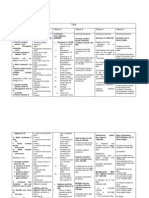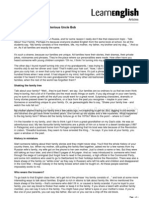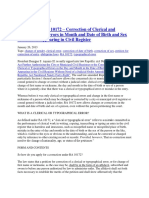Maths Year 6 Yearly Plan
Maths Year 6 Yearly Plan
Uploaded by
Mohd RedzuanCopyright:
Available Formats
Maths Year 6 Yearly Plan
Maths Year 6 Yearly Plan
Uploaded by
Mohd RedzuanOriginal Description:
Copyright
Available Formats
Share this document
Did you find this document useful?
Is this content inappropriate?
Copyright:
Available Formats
Maths Year 6 Yearly Plan
Maths Year 6 Yearly Plan
Uploaded by
Mohd RedzuanCopyright:
Available Formats
YEARLY PLAN MATHEMATICS YEAR 6 SK TABUAN ULU, KUCHING 2008 Week 1st Topic 1: Whole Numbers Learning Area
a Numbers up to seven digits Learning Learning Outcomes Objective FIRST TERM 1. Develop i) Name and write numbers up to number sense up seven digits. to seven digits ii) Determine the place value of the digits in any whole number of up to seven digits. iii) Express whole numbers in a. decimals b. fractions of a million and vice-versa. iv) Compare number values up to seven digits. v) Round of numbers to the nearest tens, hundreds, thousands, ten thousands, hundred thousands and millions. i) Add any two to five numbers to 9 999 999. ii) Subtract a. one number from a bigger number less than 10 000 000. b. successively from a bigger number less than 10 000 000. Remark
2nd
1: Whole Numbers
Basic operations with numbers up to seven digits
2. Add, subtract, multiply and divide numbers involving numbers up to seven digits.
iii) Multiply up to six-digit numbers with a. a one-digit number b. a two-digit number c. 10, 100 and 1000. iv) Divide numbers of up to seven digits by a. a one-digit number b. 10, 100 and 1000 c. a two-digit number v) Solve a. addition b. subtraction c. multiplication d. division problems involving numbers up to seven digits. 3rd 1: Whole Numbers Mixed Operations with numbers up to seven digits 3. Perform mixed operations with whole numbers. i) Compute mixed operations problems involving addition addition and multipication. ii) Compute mixed operations problems involving subtraction and division. iii) Compute mixed operations problems involving brackets. iv) Solve problems involving mixed operations on numbers of up to seven digits. 4th 2: Fractions Addition of fractions 1. Add three mixed numbers with denominators i) Add three mixed numbers with the same denominators of up to 10.
of up to 10.
ii) Add three mixed numbers with different denominators of up to 10. iii) Solve problems involving addition of mixed numbers.
Subtraction of Fractions
2. Subtract mixed numbers with denominators of up to 10.
i) Subtract involving three mixed numbers with the same denominator of up to 10. ii) Subtract involving three mixed numbers with different denominators of up to 10. iii) Solve problems involving subtraction of mixed numbers.
5th
2: Fractions
Multiplication of Fractions
3. Multiply any mixed number with a whole number up to 1000. 4. Divide fractions with a whole number and a fraction.
i) Multiply mixed numbers with a whole number.
6th
2: Fractions
Division of Fractions
i) Divide fractions with a. a whole number b. a fraction. ii) Divide mixed numbers with a. a whole number b. a fraction. i) Add and subtract three to four decimal numbers of up to 3 decimal places involving a. decimal numbers only b. whole numbers and decimal numbers.
7th 8th
3: Decimals
Mixed Operations with Decimals
1. Perform mixed operations of addition and subtraction of decimals of up to 3 decimal places.
9th 10th
4:Percentage
Relationship between Percentage, Fraction and Decimals
1. Relate fractions and decimals to percentage.
i) Convert mixed numbers to percentage. ii) Convert decimal numbers of value more than 1 to percentage. iii) Find the value for a given percentage of a quantity. iv) Solve problems in real context involving relationships between percentage, fractions and decimals.
11th 12th
5: Money
Money up to RM10 million
1. Use and apply number sense in real context involving money. 1. Use and apply knowledge of time to find the duration.
i) Perform mixed operations with money up to a value of RM10 million. ii) Solve problems in real context involving computation of money. i) Calculate the duration of an event in between a. months b. years c. dates ii) Compute time period from situations expressed in fractions of duration. iii) Solve problem in real life context involving computation of time duration. I) Compute length from a situation expressed in fraction. ii) Solve problem in real context involving computation of length. i) Compute mass from a situation
13th 15th
6: Time
Duration
16th 17th
7: Length
Computation of Length
1. Use and apply fractional computation to problems involving length. 1. Use and apply
18th 19th
8: Mass
Computation of
Mass
fractional computation to problems involving mass. 1. Use and apply fractional computation to problems involving volume of liquid.
expressed in fraction. ii) Solve problem in real context involving computation of mass. i) Compute volume of liquid from a situation expressed in fraction. ii) Solve problem in real context involving computation of volume of liquid.
20th 21st
9: Volume of Liquid
Computation of Volume of Liquid
22nd 23rd 24th 10: Shape and Space TwoDimensional Shapes
First Term Examination SECOND TERM 1. Find the i) Find the perimeter of a two perimeter and area dimensional composite shapes of two or of composite twomore quadilaterals and triangles. dimensional ii) Find the area of a two-dimensional shapes. composite shape of two or more duadrilaterals and triangles. iii) Solve problems in real contexts involving calculation of perimeter and area of two-dimensional shapes.
25th 26th
10: Shape and Space
ThreeDimensional Shapes
1. Find the surface area and volume of composite threedimensional shapes.
i) Find the surface area of a threedimensional composite shape of two or more cubes and cuboids. ii) Find the volume of a threedimensional composite shape of two or more cubes and cuboids. iii) Solve problems in real contexts involving calculation of surface area and volume of three-dimensional shapes.
27th
11: Data Handling
Average
1. Understand and compute average
i) Calculate the average of up to five numbers. ii) Solve problems in real contexts involving average.
28th - 29th
11: Data Handling
Organising and Interpreting Data
1. Organise and interpret data from tables and charts.
i) Construct a pie chart from a given set of data. ii) Determine the frequency, mode, range, mean, maximum and minimum value from a pie chart.
30th UPSR
Revision, Trial Test (Pre UPSR Test)
Prepared by : NG SENG HON Year 6 Mathematics Teacher
You might also like
- New Countdown TG 2 (3rd Edition) PDFDocument68 pagesNew Countdown TG 2 (3rd Edition) PDFFaisal100% (3)
- Unfuck Your Worth Workbook - Manage Your Money, Value Your Own Labor, and Stop FinancialDocument160 pagesUnfuck Your Worth Workbook - Manage Your Money, Value Your Own Labor, and Stop FinancialJessi Gordon75% (4)
- Clinical Chemistry McqsDocument26 pagesClinical Chemistry McqsAhmed Aboamer100% (10)
- Unit 3. Modal Verbs. Theory and ExerciseDocument6 pagesUnit 3. Modal Verbs. Theory and Exerciseizasbj0% (2)
- SAP Project Systems TrainingDocument6 pagesSAP Project Systems Trainingitprofessionalsnetwo0% (5)
- NNNNNNNNNNNNNNNNNNNNNNNNNNNNNNNNNNNNNNNNNNNNNNNNNNNNNNNNNNNNNNNNNNNNNNNNNNNNNNNDocument6 pagesNNNNNNNNNNNNNNNNNNNNNNNNNNNNNNNNNNNNNNNNNNNNNNNNNNNNNNNNNNNNNNNNNNNNNNNNNNNNNNNNor AishahNo ratings yet
- Mathematics Yearly Plan (Year Six) : 1. Whole NumbersDocument3 pagesMathematics Yearly Plan (Year Six) : 1. Whole NumbersRamziah BongsuNo ratings yet
- Mathematics Yearly Plan (Year Six) : 1. Whole NumbersDocument3 pagesMathematics Yearly Plan (Year Six) : 1. Whole NumbersAdemizan AhadNo ratings yet
- Mathematics Yearly Plan (Year 6) Sk. Kem Terendak 1 Encik Ramli Bin BabaDocument4 pagesMathematics Yearly Plan (Year 6) Sk. Kem Terendak 1 Encik Ramli Bin BabaFaridah Binti KamaludinNo ratings yet
- RPT Mat Year 6Document6 pagesRPT Mat Year 6Kayalvile Vijaya KumarNo ratings yet
- Math Y6 Yearly PlanDocument7 pagesMath Y6 Yearly PlanAnna NintehNo ratings yet
- Rancangan Tahunan Math Tahun 6 2013 BiDocument10 pagesRancangan Tahunan Math Tahun 6 2013 Binaim8889No ratings yet
- Rancangan Tahunan MatematikDocument19 pagesRancangan Tahunan MatematikHailmi OthmanNo ratings yet
- MT Yearly Plan Year 1 6Document6 pagesMT Yearly Plan Year 1 6abusufian80No ratings yet
- Rancangan Tahunan Math Tahun 5 2012 MS Excell Shared by AzyDocument13 pagesRancangan Tahunan Math Tahun 5 2012 MS Excell Shared by AzyTravis MonroeNo ratings yet
- Rancangan Tahunan Math Tahun 6 - 2013 - BiDocument10 pagesRancangan Tahunan Math Tahun 6 - 2013 - BimrdanNo ratings yet
- Rancangan Tahunan Math Tahun 6 2013 BiDocument10 pagesRancangan Tahunan Math Tahun 6 2013 BiNajwa NurNo ratings yet
- Matematik Tahun 4Document10 pagesMatematik Tahun 4tanwlbmNo ratings yet
- Yearly Plan MathsDocument8 pagesYearly Plan MathsTasaratha Rajan AnamalaiNo ratings yet
- Mathematics Year 4: Cikgu Osman B. SaidDocument10 pagesMathematics Year 4: Cikgu Osman B. SaidFaridah AbdullahNo ratings yet
- Mathematics Yearly Plan (Year 5) 2010: WE EK Topic / Learning Areas Learning Objectives / Learning Outcome RemarksDocument10 pagesMathematics Yearly Plan (Year 5) 2010: WE EK Topic / Learning Areas Learning Objectives / Learning Outcome RemarksMoorsyidee MokhtaruddinNo ratings yet
- Yearly Plan Mathematic Year 6Document8 pagesYearly Plan Mathematic Year 6Rosni OthmanNo ratings yet
- Rpt&Plan-j Math Year 4Document27 pagesRpt&Plan-j Math Year 4Kee SekKhaiNo ratings yet
- Rancangan Tahunan Matematik Tahun 5 2013Document8 pagesRancangan Tahunan Matematik Tahun 5 2013Nurulnaim OmarNo ratings yet
- Topic Learning Area Learning Objectives Learning Outcomes: Yearly Plan Mathematics Year 5Document19 pagesTopic Learning Area Learning Objectives Learning Outcomes: Yearly Plan Mathematics Year 5ranj19869No ratings yet
- Rancangan Tahunan Matematik Tahun 6 - 2012Document6 pagesRancangan Tahunan Matematik Tahun 6 - 2012mrdanNo ratings yet
- RPT MT Y5 2012Document9 pagesRPT MT Y5 2012Ani HaniNo ratings yet
- RPT Mathematics Year 4Document9 pagesRPT Mathematics Year 4YoNz AliaTiNo ratings yet
- RPT & Plan-J Math Year 5 2012Document26 pagesRPT & Plan-J Math Year 5 2012sapuanazianNo ratings yet
- Year3 Mat HSPDocument8 pagesYear3 Mat HSPyuslinaaNo ratings yet
- Week Topic / Learning Area Learning Objective / Learning Outcomes Suggested Activities 1 Whole NumbersDocument11 pagesWeek Topic / Learning Area Learning Objective / Learning Outcomes Suggested Activities 1 Whole NumbersGane GanesanNo ratings yet
- RPT & Plan-J Math Year 4Document27 pagesRPT & Plan-J Math Year 4Syafiah EppieNo ratings yet
- Yearly Plan Year 3Document8 pagesYearly Plan Year 3Shima OmarNo ratings yet
- Yearly Plan Mathematics Year 6 2013 Topic/ Learning Area Objectives/ Learning Out Comes RemarksDocument2 pagesYearly Plan Mathematics Year 6 2013 Topic/ Learning Area Objectives/ Learning Out Comes RemarksNor AishahNo ratings yet
- Rancangan Tahunan Matematik Tahun 5 - 2012Document8 pagesRancangan Tahunan Matematik Tahun 5 - 2012mrdan100% (1)
- Year3 Mat HSPDocument8 pagesYear3 Mat HSPShazwani HamzahNo ratings yet
- Yearly Scheme of Work Year 4 2013Document15 pagesYearly Scheme of Work Year 4 2013muhdmudzakkirNo ratings yet
- Matematik Tahun 2Document6 pagesMatematik Tahun 2Azmin OsmanNo ratings yet
- RPT & Plan-J Math Year 5 2010Document20 pagesRPT & Plan-J Math Year 5 2010Zoe KooNo ratings yet
- Curriculum Specifications Mathematics For Year 3 Yearly Plan 2005Document8 pagesCurriculum Specifications Mathematics For Year 3 Yearly Plan 2005Khaulah Al-HumayyraNo ratings yet
- Learning Outcome Years 5Document6 pagesLearning Outcome Years 5Ardent HatredNo ratings yet
- Yearly Plan Y4 2012Document13 pagesYearly Plan Y4 2012Fauzia AngelNo ratings yet
- RPT MT THN4Document14 pagesRPT MT THN4Sk Saujana Impian DuaNo ratings yet
- RPT MT THN4Document14 pagesRPT MT THN4startecerNo ratings yet
- RPT: Mathematics Year 5Document20 pagesRPT: Mathematics Year 5man_zero1984No ratings yet
- RPT Math Tahun 4 2013Document11 pagesRPT Math Tahun 4 2013Preloved BoutiqeuNo ratings yet
- Maths Year 5Document9 pagesMaths Year 5Nurul KikinNo ratings yet
- Mathematics Yearly Plan (Year 4)Document9 pagesMathematics Yearly Plan (Year 4)Mhreal PetronasNo ratings yet
- Curriculum Specifications Mathematics For Year 3 Yearly Plan 2005Document8 pagesCurriculum Specifications Mathematics For Year 3 Yearly Plan 2005Muhamad IrhamNo ratings yet
- Maths Year 3Document0 pagesMaths Year 3SOlero MAniskuNo ratings yet
- Mathematics Yearly Plan (Year 5) : Week Topic / Learning Areas Learning Objectives / Learning Outcome RemarksDocument8 pagesMathematics Yearly Plan (Year 5) : Week Topic / Learning Areas Learning Objectives / Learning Outcome RemarksMhreal PetronasNo ratings yet
- Yearly Plan 2010 Math Y3Document8 pagesYearly Plan 2010 Math Y3Cpt MillerNo ratings yet
- RPT MT THN2Document9 pagesRPT MT THN2Hasnawati BachoNo ratings yet
- New Countdown TG 2Document68 pagesNew Countdown TG 2Kehkashan KhanNo ratings yet
- Mathematics Yearly Plan Y5Document12 pagesMathematics Yearly Plan Y5skppasir0% (1)
- Mathematics Year 3 2012Document12 pagesMathematics Year 3 2012Izyan IsmailNo ratings yet
- RPT MT THN2Document9 pagesRPT MT THN2Muhammad Fadzli HamzahNo ratings yet
- Year3 Mat HSP SGT BagusDocument9 pagesYear3 Mat HSP SGT BagusMaryah Yahya AzlimdnorNo ratings yet
- RPT MT THN4Document17 pagesRPT MT THN4Yakin DayyanNo ratings yet
- Mathematics Yearly Plan 2014 Year 5 Week Topic / Learning Area Learning Objectives / Learning OutcomesDocument8 pagesMathematics Yearly Plan 2014 Year 5 Week Topic / Learning Area Learning Objectives / Learning OutcomesMohd ZahariNo ratings yet
- Master Fundamental Concepts of Math Olympiad: Maths, #1From EverandMaster Fundamental Concepts of Math Olympiad: Maths, #1No ratings yet
- Let's Practise: Maths Workbook Coursebook 5From EverandLet's Practise: Maths Workbook Coursebook 5No ratings yet
- Let's Practise: Maths Workbook Coursebook 6From EverandLet's Practise: Maths Workbook Coursebook 6No ratings yet
- Blue and Gray Shark 4 Panel Comic StripDocument6 pagesBlue and Gray Shark 4 Panel Comic StripAlexis Gabriel Del ValleNo ratings yet
- Wright Missouri CCC2003Document13 pagesWright Missouri CCC2003Andrés Esteban Quezada VenegasNo ratings yet
- Theories of First Language AcquisitionDocument4 pagesTheories of First Language Acquisitionevilfairy90No ratings yet
- Health Promotion On Nutrition For Children Under FiveDocument21 pagesHealth Promotion On Nutrition For Children Under FiveSinta WuLandariNo ratings yet
- Susunan Acara Bahasa InggrisDocument2 pagesSusunan Acara Bahasa InggrisSholihin MuhammadNo ratings yet
- Chestionarul in Cercetarea SociologicaDocument15 pagesChestionarul in Cercetarea SociologicaCristian MovilescuNo ratings yet
- Fs SP Gsci Agriculture Index LTRDocument3 pagesFs SP Gsci Agriculture Index LTRTaylor MaluegNo ratings yet
- Pile DesignDocument44 pagesPile DesignEr Navneet JassiNo ratings yet
- Castle Ironwood PDFDocument26 pagesCastle Ironwood PDFJamesNo ratings yet
- The Odyssey Part 2Document18 pagesThe Odyssey Part 2jkkapadia1100% (1)
- Black SheepDocument2 pagesBlack SheepromanzahanNo ratings yet
- Management Training and Advisory Center (Mtac) : Building Capacity For Enterprise DevelopmentDocument28 pagesManagement Training and Advisory Center (Mtac) : Building Capacity For Enterprise Developmentkitderoger_391648570No ratings yet
- Xi-Narration SpeechDocument9 pagesXi-Narration SpeechAr Abu Tarek KhokaNo ratings yet
- Uniply DPS PDocument1 pageUniply DPS PNeel MehtaNo ratings yet
- MK 2102-BAE2020 - Accounting For Merchandising ReDocument3 pagesMK 2102-BAE2020 - Accounting For Merchandising ReAngela Thrisananda0% (1)
- Aquarium DescriptionDocument2 pagesAquarium DescriptiongerardoNo ratings yet
- Kelly Steffen - Resume - 2018Document2 pagesKelly Steffen - Resume - 2018api-419130508No ratings yet
- Maths IGCSE Summer Transition WorkDocument35 pagesMaths IGCSE Summer Transition WorkHamedNo ratings yet
- Act. 4d Joints Body Movements FOR STUDENTSDocument9 pagesAct. 4d Joints Body Movements FOR STUDENTSShane SayconNo ratings yet
- A Project Report ON A Study On Consumer Satisfaction of DoorDocument7 pagesA Project Report ON A Study On Consumer Satisfaction of Doorjassi nishadNo ratings yet
- SyllabusDocument8 pagesSyllabusDenise CruzNo ratings yet
- Ijcb 44B (6) 1239-1242Document4 pagesIjcb 44B (6) 1239-1242Sarathkumar PathivadaNo ratings yet
- Thesis Statement For Racism in OthelloDocument8 pagesThesis Statement For Racism in OthelloJeff Brooks100% (2)
- Rizal's Siblings WT DescriptionDocument3 pagesRizal's Siblings WT DescriptionPeculiar JenNo ratings yet
- Defence Media ListDocument4 pagesDefence Media ListYasin HamidaniNo ratings yet
- Republic Act No. 10172 - Correction of Clerical and Typographical Errors in Month and Date of Birth and Sex of A Person Appearing in Civil RegisterDocument2 pagesRepublic Act No. 10172 - Correction of Clerical and Typographical Errors in Month and Date of Birth and Sex of A Person Appearing in Civil RegisterRomulo Trajano Espalmado Jr.100% (1)

























































































